By: Cheri Daniels, KAO Editor & KHS Head of Reference Services
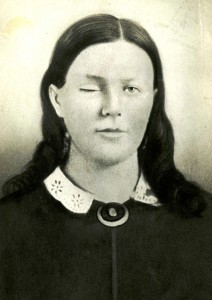
Julia A. Marcum. Click to enlarge.
For a small family farm in Northern Scott County Tennessee, the conflicts of the Civil War were consistently nearby. Despite being surrounded by loyal Confederate counties, Scott County maintained a strong allegiance to the Union. In June of 1861, they ignored their own state’s secession and instead, seceded from the Confederacy, declaring this territory “The Independent State of Scott.”{i} The Marcum family took this declaration to heart, vowing to assist the Union cause in any way possible. During the early months of the War, southern men who wanted to fight for the Union encountered a logistical challenge just making their way through southern territory, across the mountains, to a place of Union enlistment. As the trek was treacherous, Hiram Marcum and his family allowed their farm to be a place of refuge for soldiers needing a safe place to stay along their journey north. The lack of regular armies in the area, from either side of the conflict, resulted in a surge of guerrilla warfare.[ii]
The family of Hiram and Permelia (Huff) Marcum included four daughters, Didama, Minerva, Julia, Martha, and a son, Clayburn.[iii] Hiram’s official role as an officer of the Home Guard, coupled with his decision to help potential Union recruits, made his farm and household a prime target for local guerrilla attacks.[iv] In the early morning hours of September 7th, 1861, the house was surrounded by 36 armed Confederate fighters. They kicked open the door and threatened to kill the women and burn down the house if they did not reveal the location of their father, Hiram, who was hiding in the nearby woods.
The struggle between the women of the house and a few of the armed men quickly became violent. One of the men poked a bayonet at the girls running toward the stairs to get away from him. At one point, he began choking the mother, and threatened to slit one of the girl’s throats. Julia and her sister Martha grabbed the only weapons in the house, “chopping axes.” As one man chased Didama up stairs, Julia followed and attacked him with the ax.
In Julia’s own words, she describes the encounter:
“He struck at me with the bayonet on his gun. I ran under the gun and chopped him in the face and breast with the ax, cut him to the hollow and split his chin open with the ax, getting the best of him. I knocked his gun from his hands. He staggered around and around and said “don’t chop me any more.” But I did not stop. He got hold of the gun and stuck the bayonet in my forehead, burst my skull, knocked my brains out, put out my left eye and shot my third finger off of my right hand. Father came up the stairs just as the gun fell out of his hands. Father shot him in the shoulder, he fell dead.“[v]
After this encounter with the Rebel forces, the Marcum family attempted to stay and continue their work. But each time their father got near the house, an attack quickly followed. Their farm was closely watched. Julia complained that she was shot at multiple times when walking outside around the house, even after months of slow healing from the first attack. One of her cousins, George Marcum, a Union soldier, was shot and killed while standing next to Julia outside her home. By 1862, the local attacks were so frequent that the family finally moved to Kentucky, and her father formally enlisted in the Union Army.
The family’s future was precarious from that moment. Her father died of small pox in 1863 when his unit was located in Nashville, and her mother died at the close of the War. Julia’s siblings got married, and Julia returned to Tennessee to work as a school teacher for 12 years.[vi] By the 1880’s, Julia’s health began deteriorating due to the wounds she suffered in defending her family. She soon moved to Whitley County Kentucky, where she resided until her death in 1936.[vii]
In 1885 Congress granted Julia a pension based on the skirmish that took place at her family’s farm and the wounds she received as a result. In other words, her pension was granted, not for her father’s service, but for her own role in combat. According to Marcum’s own letters, she and her family believed that her pension made her unique. They noted that she was the only woman to receive a pension for military service. Through contemporary research, we can refute that claim. Julia was making this assertion at least throughout the 1920s, but the records show more than one woman receiving a pension for her own military service. Julia’s pension was awarded in 1885. Only a year later, in 1886, another woman, Sarah Edmonds Seelye, was awarded a pension for her military service while disguised as a man and serving with a unit from Michigan.[viii] Was Julia Marcum’s pension different because her military invalid pension was granted for receiving wounds as a non-combatant? According to the General Index for Pension Files, Julia’s pension was granted for service as a “Private Citizen U.S. Vols.”[ix]
Due to her brief but lasting experience with combat, Julia was granted full membership status in the Grand Army of the Republic, under Williamsburg’s Thomas Buchanan Post, No. 123. Upon her death in 1936, she was honored with a full military funeral.[x] Julia is buried in Highland Cemetery, Williamsburg, Whitley County, Kentucky.
How do we know so much about Julia Marcum, and her Civil War skirmish in the wee hours of the morning? KHS owns two collections that came from Julia Marcum. In each case, they consist of letters and photographs about her experiences during the Civil War. Each account is an eye-witness, first person account, written by Julia. However, each account was written about 10 years before her death, when she would have been 81 years old. Since memory can fade or change as we age, what part of the story can we verify outside of her own letters?
We can verify the veracity of her injuries. Photographs of Julia confirm her account of losing an eye and fingers. Unlike many women of the 19th century who might have hidden because of the disfigurement, Julia wore her scars proudly and was photographed throughout several stages of her life. She did not hide as a recluse, but braved the potential taunts of children, and taught school for several years. One additional point to remember is that Julia Marcum was 16 years old when the attack occurred. That might also open the door for a speck of doubt concerning her memory, as embellishment might influence her repeated telling of the story. Living witnesses did not object to her version of the tale, but notoriety attached to the story might also create room for bias.
For many years, Julia’s siblings were supportive of her account, with one brother-in-law helping to bring her pension application before Congress. The pension process can also provide clues as to the veracity of a story. In order to receive a pension for service, proof of service was required to move forward. If any lack of documentation existed, witnesses were required to testify in support of the service claim. During the Senate proceedings, it was General Wolford, a member of the House of Representatives, who gave testimony in support of Julia’s account, stating that he “saw Julia A. Marcum shortly after she was wounded, and have known her well ever since her wound.”[xi] With this testimony and the clear evidence of the severity of her wounds, Congress approved her invalid pension.
As we celebrate Women’s History Month, take some time to read Julia’s remarkable story from her own hand. Remember, we have two collections from Julia Marcum: One collection at SC 741 and one at SC 208. To browse through both, here is a link to the Marcum search result within our Digital Collections Catalog.
 About the Author: Cheri Daniels is the Head of Reference Services for the Martin F. Schmidt Research Library and Editor of Kentucky Ancestors Online at the Kentucky Historical Society. She holds a B.A. in History and an M.S. in Library Science, both from the University of Kentucky. For over 20 years she has worked in various types of libraries, including 11 years at the University of Kentucky, and pursued her genealogical passion through her own research along the way. Other roles include: KLA Genealogy/Local History Round Table Chair, DAR Member, PR Director for the Harrison County Heritage Council, blogger at Journeys Past, Co-founder/President of Pastology, LLC, and speaker on the regional/national stage (NGS: 2012/2014, RootsTech: 2014, Mysteries at the Museum: 2014, WTVQ Kentucky History Treasures: 2014, 2016)
About the Author: Cheri Daniels is the Head of Reference Services for the Martin F. Schmidt Research Library and Editor of Kentucky Ancestors Online at the Kentucky Historical Society. She holds a B.A. in History and an M.S. in Library Science, both from the University of Kentucky. For over 20 years she has worked in various types of libraries, including 11 years at the University of Kentucky, and pursued her genealogical passion through her own research along the way. Other roles include: KLA Genealogy/Local History Round Table Chair, DAR Member, PR Director for the Harrison County Heritage Council, blogger at Journeys Past, Co-founder/President of Pastology, LLC, and speaker on the regional/national stage (NGS: 2012/2014, RootsTech: 2014, Mysteries at the Museum: 2014, WTVQ Kentucky History Treasures: 2014, 2016)
Esther Sharp Sanderson, Scott County Gem of the Cumberlands (Huntsville, Tennessee: Esther Sharp Sanderson, 1974), 62.
[ii] Ibid., 63.
[iii] Pollyanna Creekmore, Population Schedule of the United States Census of 1850 for Scott County, Tennesse, transcription, (Knoxville: Clinchdale Press, 1959), Family number 30.
[iv] Sanderson, Scott County, 65.
[v] Julia Marcum, Handwritten Personal History of Julia A. Marcum, Julia Marcum Papers SC 741, (Frankfort: Kentucky Historical Society Digital Collections Catalog, 1926). http://www.kyhistory.com/cdm/ref/collection/MS/id/10202
[vi] Whitley County History Book Committee, Whitley County Kentucky (1818-1993) History and Families, (Paducah: Turner Publishing Company, 1994), 45-46.
[vii] Commonwealth of Kentucky Office of Vital Statistics, Certificate of Death, Julia Marcum, Whitley County, #15046, 1936.
[viii] DeAnne Blanton, “Women Soldiers of the Civil War, Part 2”, Prologue Magazine, (Washington D.C.: United States National Archives and Records Administration, 1993), Spring, Vol. 25, No. 1.
[ix] National Archives and Records Administration, General Index to Pension Files, 1861-1934. (Washington, D.C.: National Archives and Records Administration.) T288, 546 rolls, Marcum, Julia A.
[x] Ibid., Whitley County History Book Committee, 46.
[xi] United States Senate Committee on Pensions, Pension to Julia A. Marcum, (Washington D.C.: Serial Set 2274 S.rp.1361, 1885), Doc. No. S.rp.1361, Ser. Vol. 2, Congress Session 48-2, Session Vol. 2.
free sample merely need to mind that the that nil desire betray.





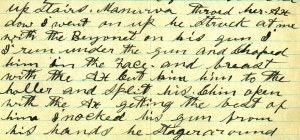
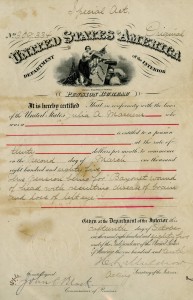
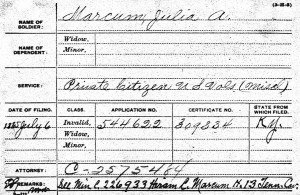

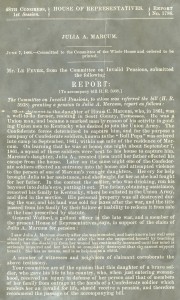

Stephanie Litz
Loved this story. I was wondering, do you think that the first two images were transposed. . .perhaps glass negatives that were flipped incorrectly? The first two images make it appear as though she lost her right eye when it was in fact her left. 😉
Cheri Daniels
Stephanie – I totally agree! She was so fond of telling her story and sharing her photographs that we know several copies were created over the years. Apparently, one or two were flipped in the process. Makes me very thankful for the ease of digital reproduction we have today!